Unveiling the Blades: How to Choose the Best Japanese Cooking Knives
Japanese knives, with their sleek design and razor-sharp edge, have earned a reputation for precision and elegance. But navigating the diverse world of these blades can be daunting, especially with specialized knives for different tasks. Worry not, culinary explorer! This guide dives into the best Japanese knives for your specific needs, empowering you to tackle any ingredient with confidence.
Chopping Champion: The Santoku and the Nakiri

When it comes to vegetable domination, two knives reign supreme. The Santoku, aptly named “three virtues” for its versatility, boasts a straight, sheep’s foot blade and a flat profile. This allows for both rocking and push-cutting, making it perfect for chopping, slicing, and mincing all types of vegetables, from leafy greens to hard root vegetables. Its smaller size compared to a chef’s knife also offers better control for intricate cuts.
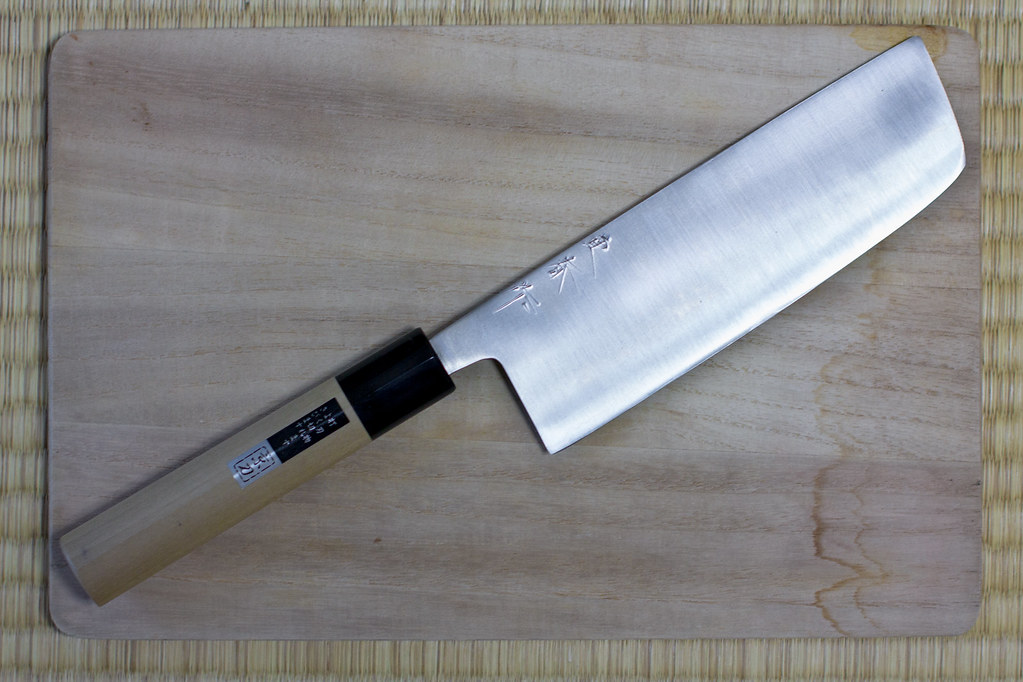
For those dedicated to the vegetarian path, the Nakiri is heaven-sent. This rectangular knife with a flat blade excels at precision cuts and julienne work. Its lack of a pointed tip prevents piercing delicate vegetables, while its thin profile ensures clean, smooth slices. Imagine perfectly uniform carrot slivers for stir-fries or paper-thin cucumber ribbons for salads – the Nakiri makes these dreams a reality.
Meat Maestro: The Gyuto and the Deba
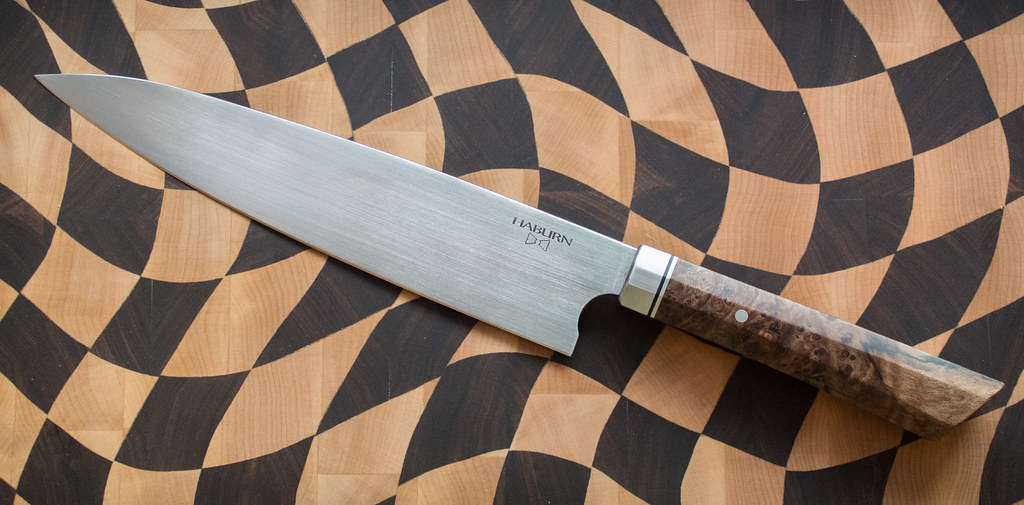
Carnivores, rejoice! The Gyuto, the Japanese equivalent of a chef’s knife, is your all-around powerhouse. With a longer, curved blade, it tackles larger cuts of meat and bones with ease. Its slightly pointed tip allows for piercing and maneuvering around tougher sections, while the wider belly excels at rocking cuts for thin slices. Consider the Gyuto your trusty meat-slicing companion, from boneless chicken breasts to thick slabs of ribeye.

But for serious butchery adventures, the Deba takes the crown. This heavy-duty knife, characterized by its thick, cleaver-like blade, is designed for breaking down whole fish and tackling poultry with ease. Its weight allows for powerful chops through bones and joints, while the wide blade provides ample surface area for handling larger cuts. If you’re a fan of preparing whole chickens or deboning fish from scratch, the Deba is your ultimate weapon.
Seafood Samurai: The Sashimi Specialist and the Yanagiba

For the sushi enthusiast, two knives elevate your fish preparation to an art form. The Sashimi Specialist, a smaller version of the Gyuto with a thinner blade, delivers pristine, paper-thin sashimi slices. Its maneuverability allows for precise control, ensuring each slice melts on the tongue.
For the ultimate sashimi master, the Yanagiba is the pinnacle. This long, single-beveled blade boasts unmatched thinness, designed for the smoothest possible cuts. While requiring delicate handling, the Yanagiba rewards with translucent sashimi slices that are a true culinary masterpiece.
Key Factors to Consider When Choosing a Japanese Knife
The allure of a razor-sharp Japanese knife is undeniable, but amidst the vast array of options, choosing the right one can feel overwhelming. Fear not, aspiring chef! This guide unpacks the crucial factors to consider, ensuring your journey into the world of Japanese blades is informed and satisfying.
Steel, the Soul of the Blade:
- High-Carbon vs. Stainless Steel: High-carbon knives hold a sharper edge longer but require more maintenance and are prone to rust. Stainless steel offers convenience and rust resistance, but edge retention might be slightly lower. Consider your comfort level with maintenance and desired sharpness.
- Hardness and Sharpening: Hardness, measured on the Rockwell scale, affects edge retention. Higher numbers (58+) hold an edge longer but require specialized sharpening tools. Lower numbers (50-55) are easier to sharpen at home but require more frequent touch-ups.
Blade Shape and Function
- Santoku: Versatile for vegetables and smaller cuts.
- Gyuto: All-around chef’s knife for meat, vegetables, and some fish.
- Nakiri: Vegetable specialist for chopping and julienne work.
- Deba: Heavy-duty cleaver for butchering meat and poultry.
- Sashimi Specialist: Thin blade for precise sashimi slices.
- Yanagiba: Single-beveled masterpiece for ultimate sashimi mastery.
Handle Material and Comfort
- Western: Familiar handle style with wood, plastic, or composite materials.
- Japanese (Wa): Octagonal wooden handle known for balance and control.
- Fit and Feel: The most Crucial factor! Hold the knife and ensure it feels comfortable and balanced in your hand.
Price and Investment
- Japanese knives are an investment. High-quality blades can last a lifetime.
- Start with a mid-range option to learn your preferences before splurging on high-end knives.
- Consider value over just price. A well-made, mid-range knife can outperform a cheaper, high-end one.
Bonus Tip: Consider your skill level and cooking style. Beginners might benefit from a more forgiving stainless steel knife, while experienced cooks can explore high-carbon options.
Popular Japanese Knife Brands and Their Quirks
The world of Japanese knives is a diverse landscape, teeming with brands each boasting unique strengths and specialties. To aid your search for the perfect blade, we delve into some of the most popular brands, highlighting their distinct characteristics and helping you find your ideal match.
Shun: The Modern Masterpiece

Founded by the Kai corporation, Shun seamlessly blends Japanese tradition with modern technology. Their knives, known for their aesthetic beauty and comfortable Western-style handles, are particularly popular among home cooks and professional chefs alike.
Strengths:
- Sharpness: Shun knives utilize high-quality VG-10 stainless steel, ensuring exceptional edge retention.
- Ease of use: The Western-style handles offer comfort and familiarity for most users.
- Variety: Shun offers a wide range of knives, from classic Gyutos to specialized Nakiri knives.
Weaknesses:
- Price: Shun knives tend to be on the higher end of the price spectrum.
- Sharpening: While easier to sharpen than high-carbon options, specialized tools might be needed for optimal results.
Misono: The Unwavering Tradition
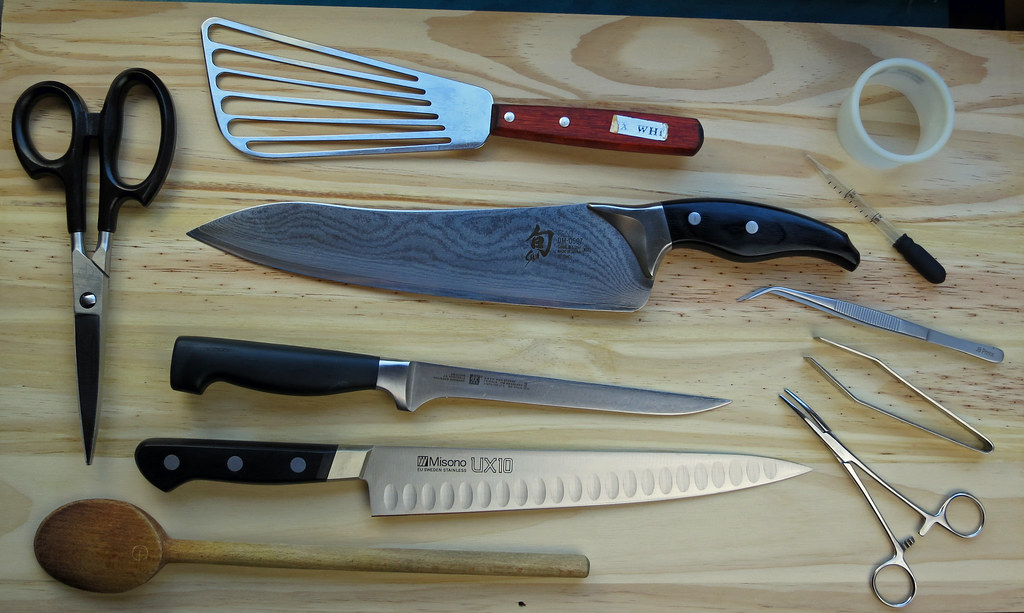
Established in 1932, Misono embodies the spirit of traditional Japanese knifemaking. Their knives, crafted from molybdenum-vanadium stainless steel, are renowned for their exceptional sharpness and durability.
Strengths:
- Edge retention: Misono knives hold an edge incredibly well, requiring less frequent sharpening.
- Craftsmanship: Each knife is meticulously hand-finished by skilled artisans.
- Value: Misono offers a good balance between quality and price compared to some high-end brands.
Weaknesses:
- Limited styles: Misono primarily focuses on classic Japanese blade shapes, offering fewer options than some brands.
- Maintenance: High-carbon steel requires more care to prevent rust.
Tojiro: The Everyday Essential

For those seeking a reliable and affordable entry point into the world of Japanese knives, Tojiro stands out. Their DP series, crafted from VG-10 stainless steel, offers excellent performance at a mid-range price point.
Strengths:
- Affordability: Tojiro knives are significantly cheaper than high-end brands, making them ideal for beginners.
- Durability: The VG-10 steel ensures decent edge retention and overall sturdiness.
- Variety: Tojiro offers a wide selection of knives for various tasks and budgets.
Weaknesses:
- Aesthetics: Tojiro knives prioritize functionality over aesthetics, opting for a simpler design.
- Sharpness: While good, the edge retention might not be as impressive as high-end options.
Global Knives: The Stainless Steel Samurai
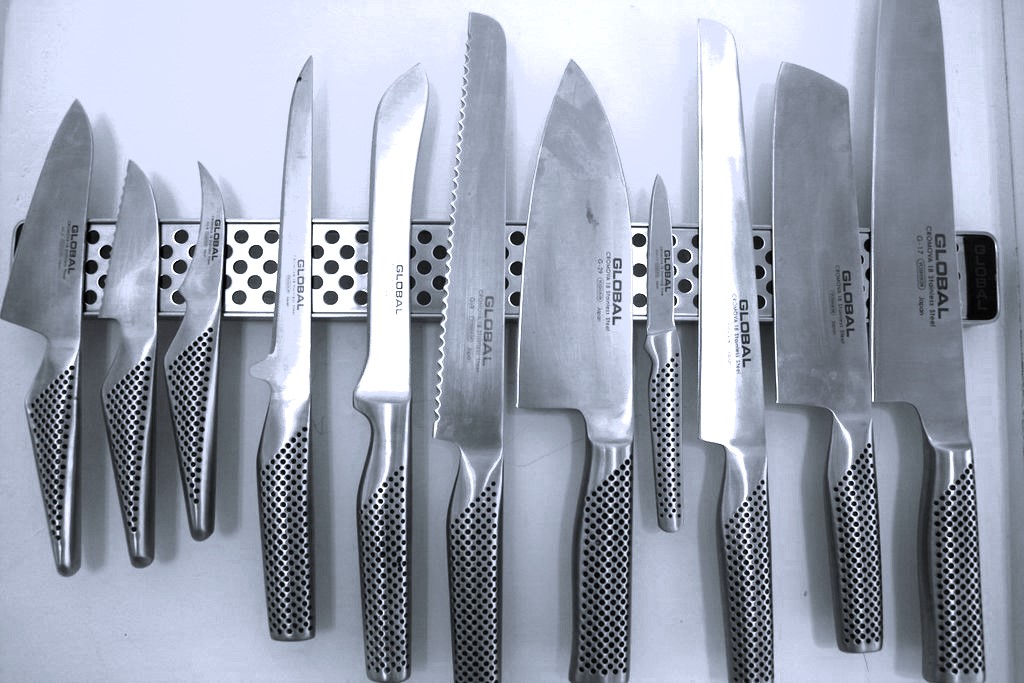
Global Knives, owned by the Yoshikin factory in Japan, have carved a niche in the culinary world with their distinctive stainless-steel design and razor-sharp blades. Emphasizing clean lines and modern functionality, Global knives stand out from traditional Japanese aesthetics, attracting both professional chefs and home cooks seeking sleek performance.
Strengths:
- Sharpness: Global knives utilize Cromova 18 stainless steel, known for its excellent edge retention and ease of sharpening.
- Stain resistance: The stainless-steel construction ensures low maintenance and rust resistance.
- Lightweight and balanced: The seamless handle design creates a lightweight and well-balanced knife, reducing fatigue during prolonged use.
- Hygienic: The seamless construction minimizes food traps, promoting cleanliness.
Weaknesses:
- Limited blade shapes: Global primarily focuses on Western-style shapes, offering fewer options for traditional Japanese preferences.
- Handle comfort: The handle design, while hygienic, might not suit everyone’s preference, especially for those accustomed to traditional Japanese handles.
- Price: Global knives fall within the mid-range to high-end price spectrum, depending on the model.
Global is an excellent choice for:
- Cooks who prioritize ease of maintenance and sharpness.
- Those who prefer a modern aesthetic and lightweight design.
- People who appreciate hygienic properties and stain resistance.
Splurge or Save: Are Japanese knives Worth the Investment?
Ah, the age-old question: is a high-end Japanese knife truly worth the investment? While the allure of a handcrafted blade honed to razor-sharp perfection is undeniable, navigating the price tag can be daunting. Worry not, culinary explorer! This guide delves into the value proposition of high-end Japanese knives, helping you decide if the splurge is right for you.
The Allure of High-End Blades
- Unmatched Sharpness: Premium Japanese knives utilize high-carbon steel, renowned for holding an edge significantly longer than their stainless steel counterparts. This translates to effortless slicing, elevating your food preparation experience.
- Craftsmanship and Durability: Each high-end knife is a meticulous work of art, crafted by skilled artisans using time-honored techniques. This meticulousness translates to exceptional durability, potentially lasting a lifetime with proper care.
- Enhanced Control and Feel: Superior steel and well-balanced designs grant unparalleled control and feedback during use. This precision allows for intricate cuts and elevates food presentation.
- Investment in Your Passion: For dedicated cooks, a high-end knife becomes a cherished companion, enhancing the joy of cooking and signifying a commitment to culinary excellence.
Before You Splurge
- Consider Your Needs: Do you cook frequently and demand the best performance? Or are you a casual cook who values basic functionality? Align your investment with your cooking habits.
- Maintenance Commitment: High-carbon steel requires more care to prevent rust. Are you comfortable with regular honing and occasional sharpening?
- Budgetary Reality: High-end knives can be a significant investment. Ensure it aligns with your financial priorities and won’t strain your budget.
Value Beyond the Price Tag
- Long-Term Savings: While initially expensive, a high-end knife, with proper care, can outlast several cheaper knives, potentially saving you money in the long run.
- Improved Skills and Confidence: Using a superior knife can refine your cutting technique and boost your culinary confidence, leading to more enjoyable cooking experiences.
- Investment in Quality Food: Precise cuts and effortless slicing ensure optimal presentation and flavor of your dishes, elevating your culinary creations.
Mastering the Blade: The Art of Caring for Your Japanese Knife
The razor-sharp precision of a well-maintained Japanese knife elevates any cook’s experience. But unlike their Western counterparts, these delicate blades demand specific care to retain their sharpness and prevent damage. Worry not, culinary explorer! This guide equips you with the knowledge and techniques to keep your Japanese knife in pristine condition, ensuring years of joyful slicing and dicing.
Embrace the Ritual: Caring for your Japanese knife becomes a mindful ritual, fostering respect for the tool and appreciating its craftsmanship.
Cleaning Like a Pro
- Hand-wash only: Dishwashers are harsh environments, warping blades and dulling edges. Use warm, soapy water and a soft sponge.
- Clean immediately: Don’t let food residue linger. Clean your knife right after use to prevent staining and rust.
- Dry meticulously: Moisture is the enemy. Thoroughly dry your knife with a clean cloth, paying attention to crevices and the handle.
Sharpening: Keeping the Edge Keen

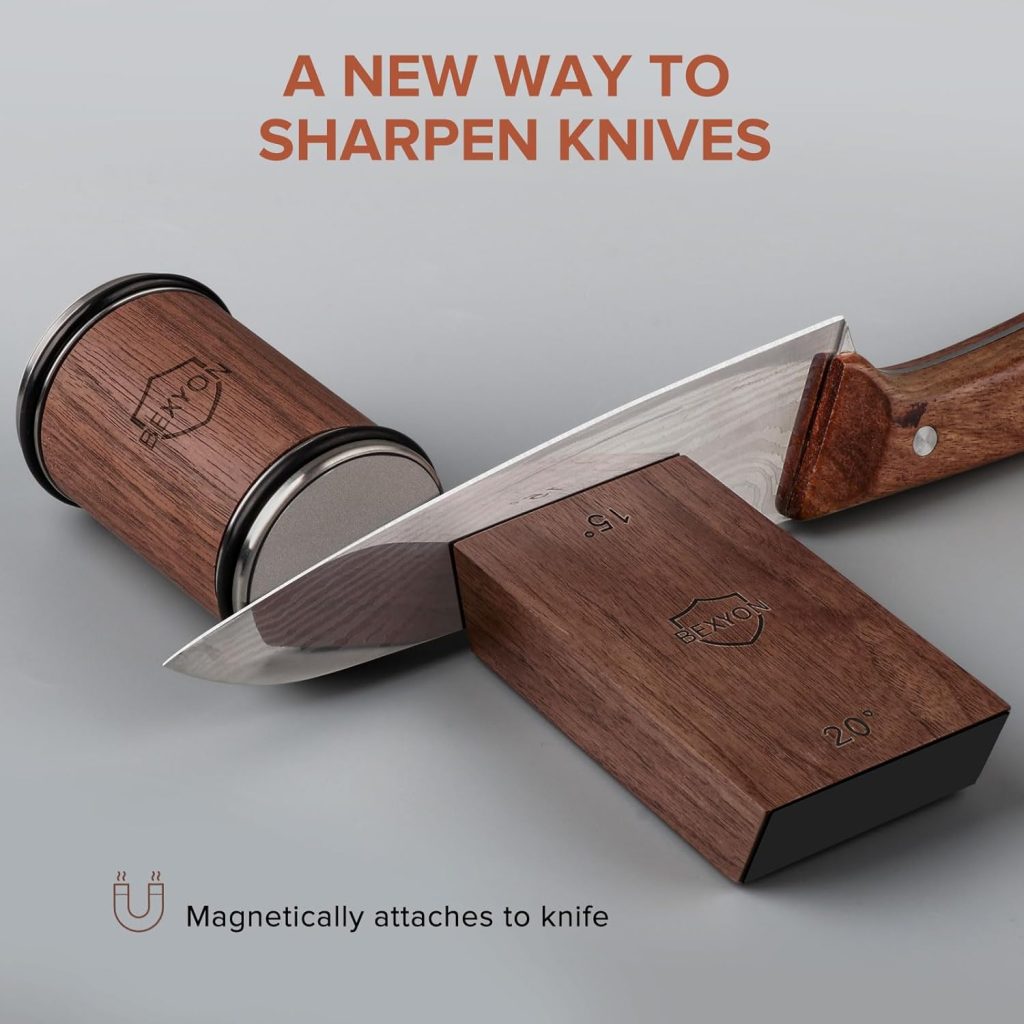
- Honing vs. Sharpening: Honing realigns the edge on a honing rod, while sharpening removes metal to create a new edge.
- Regular Honing: Hone your knife before every use to maintain its edge.
- Professional Sharpening: Every 3-6 months, depending on use, get your knife professionally sharpened by a reputable service.
Storage: Choose Wisely
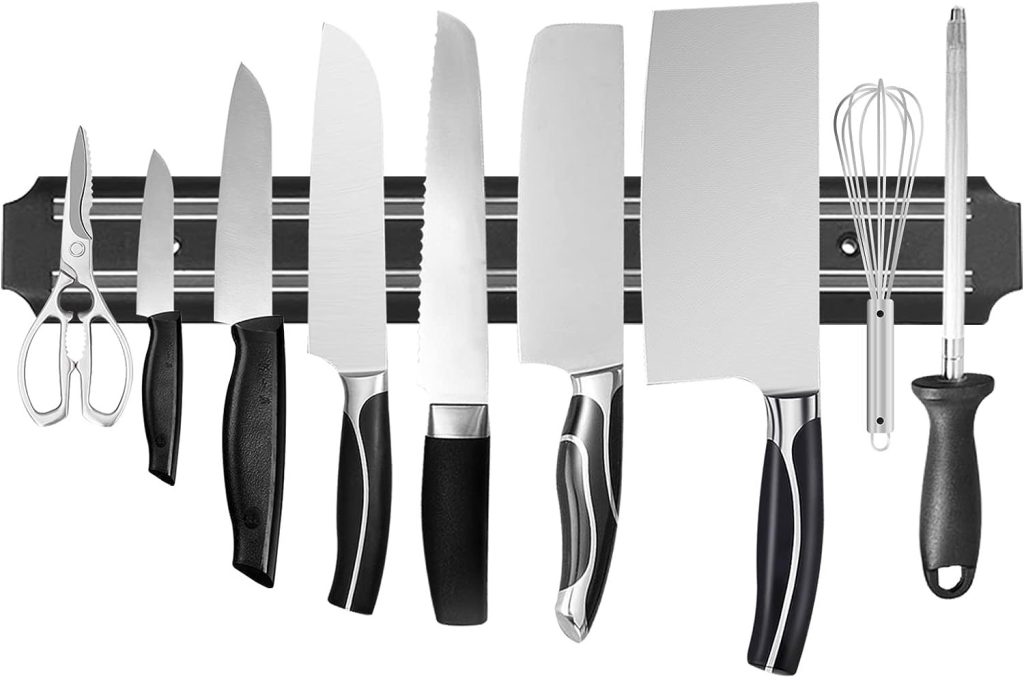
- Avoid knife blocks: They trap moisture and can dull your blade.
- Magnetic strips or knife guards: These offer safe and accessible storage, keeping your blade protected.
- Store dry: Always ensure your knife is completely dry before storing it.
Special Considerations
- High-carbon vs. Stainless Steel: High-carbon knives require stricter care to prevent rust. Wipe them with a thin layer of food-grade mineral oil after drying for extra protection.
- Handle care: Wood handles can dry out and crack. Occasionally apply a light coat of food-grade mineral oil to maintain their beauty and longevity.
Bonus Tips:
- Never use your knife for tasks it’s not meant for: Don’t pry, twist, or chop frozen foods.
- Use a cutting board: Protect your blade from dulling on hard surfaces.
- Respect the blade: Treat your knife with care and it will serve you faithfully for years to come.
Budget Blades, Big Flavors: Exploring Alternatives to Traditional Japanese Knives
The allure of Japanese knives is undeniable, but their price tag can sometimes be daunting. Fear not, budget-conscious chef! This guide explores excellent alternatives that won’t break the bank, allowing you to experience the joy of precision cutting and elevated cooking without sacrificing flavor or functionality.
Beyond the Traditional
While high-end Japanese knives boast unique qualities, several other options offer incredible performance at a more accessible price point. Let’s explore some exciting alternatives:
- Western-style knives: These familiar kitchen workhorses, like chef’s knives and santokus, are often made from durable German steel, offering good edge retention and ease of sharpening. Consider brands like Victorinox, Mercer, or Tramontina for reliable options.
- Swedish steel knives: Known for their sharpness and affordability, Swedish knives like those from Mora or JCK offer excellent value for money. They might not hold an edge as long as high-end Japanese knives, but they are easy to maintain and sharpen at home.
- Chinese cleavers: These heavy-duty knives excel at chopping vegetables and meat, making them versatile additions to any kitchen. You can find them at most Asian grocery stores or online retailers at very affordable prices.
Finding the Right Fit
Choosing the best alternative depends on your needs and preferences. Consider these factors:
- Task: What will you be using the knife for primarily? Vegetables, meat, or general kitchen tasks? Choose a knife designed for your specific needs.
- Steel type: Stainless steel offers ease of maintenance, while carbon steel provides superior sharpness but requires more care. Choose based on your comfort level and maintenance preferences.
- Handle: Do you prefer a traditional Japanese handle or a Western-style grip? Experiment with different options to find the most comfortable fit.
Budget-Friendly Tips
- Start with one good knife: Instead of buying a whole set, invest in a single, high-quality knife that will serve multiple purposes. You can add more specialized knives later.
- Look for sales and discounts: Many retailers offer regular sales or clearance sections where you can find quality knives at discounted prices.
- Consider pre-owned options: Check online marketplaces or thrift stores for gently used knives. You might find hidden gems at a fraction of the original price.
- Sharpen your existing knives: A well-maintained and sharpened knife, even if not high-end, can outperform a dull expensive one. Learn proper sharpening techniques to maximize the performance of your current knives.
The “best” knife is the one that fits your budget, preferences, and cooking style. Don’t let the price tag discourage you from exploring the world of precision cutting. With a little research and the right options, you can unlock a world of culinary possibilities without breaking the bank. So, embrace the exploration, discover what works best for you, and get ready to elevate your cooking experience with delicious results!

Your article helped me a lot, is there any more related content? Thanks!
Thanks for sharing. I read many of your blog posts, cool, your blog is very good.
Can you be more specific about the content of your article? After reading it, I still have some doubts. Hope you can help me.
Your point of view caught my eye and was very interesting. Thanks. I have a question for you.
Your article helped me a lot, is there any more related content? Thanks!
Thank you for your sharing. I am worried that I lack creative ideas. It is your article that makes me full of hope. Thank you. But, I have a question, can you help me?
Your article helped me a lot, is there any more related content? Thanks!
Your article helped me a lot, is there any more related content? Thanks!
Your article helped me a lot, is there any more related content? Thanks!
Thanks for sharing. I read many of your blog posts, cool, your blog is very good.
Can you be more specific about the content of your article? After reading it, I still have some doubts. Hope you can help me.
I don’t think the title of your article matches the content lol. Just kidding, mainly because I had some doubts after reading the article.
Thanks for sharing. I read many of your blog posts, cool, your blog is very good.
Your point of view caught my eye and was very interesting. Thanks. I have a question for you.
Your point of view caught my eye and was very interesting. Thanks. I have a question for you.
I don’t think the title of your article matches the content lol. Just kidding, mainly because I had some doubts after reading the article.
Thanks for sharing. I read many of your blog posts, cool, your blog is very good.
I don’t think the title of your article matches the content lol. Just kidding, mainly because I had some doubts after reading the article.
I don’t think the title of your article matches the content lol. Just kidding, mainly because I had some doubts after reading the article.
I don’t think the title of your article matches the content lol. Just kidding, mainly because I had some doubts after reading the article.
Thank you for your sharing. I am worried that I lack creative ideas. It is your article that makes me full of hope. Thank you. But, I have a question, can you help me?
Thanks for sharing. I read many of your blog posts, cool, your blog is very good.
Can you be more specific about the content of your article? After reading it, I still have some doubts. Hope you can help me.
Thanks for sharing. I read many of your blog posts, cool, your blog is very good.
Your article helped me a lot, is there any more related content? Thanks!
Can you be more specific about the content of your article? After reading it, I still have some doubts. Hope you can help me.
Thanks for sharing. I read many of your blog posts, cool, your blog is very good.
Your article helped me a lot, is there any more related content? Thanks!